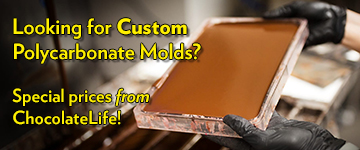Rob:
Ben is right in pointing out that the Chocovisions are not continuous tempering machines - they are batch tempering machines.
Okay - tempering basics. First. Tempering is the chocolate equivalent of annealing in metallurgy.
There are six different crystal structures that cocoa butter can assemble into when it cools down. Forms I-IV (one through four) result in a substance that melts very easy and is soft, even when at the correct temperature. Form VI (six) crystals don't melt easily and are what give chocolate a hard brittle crunch texture and sandy/pebbly texture in the mouth when melting (not very well as the melt point is at or just above body temperature). What we want is for Form V (Form Five) crystal to predominate in the mix. (Technically, there are usually always some lower form crystals floating around and like entropy, everything tends towards Form VI in the long run.)
The tempering process is all about forcing the majority of crystals that form to be Form V crystals. This is done by raising the temperature of the chocolate to melt out all the crystals (usually to about 115F), then cooling the chocolate down under controlled conditions, then warming it back up slightly to a working temperature all the while agitating (mixing) the chocolate in a controlled fashion.
This can be done entirely by hand on a marble slab. Warm chocolate is spread out on a cool surface and as it cools down it is moved around by hand. It is the agitation of the chocolate that is part of the key to proper crystal structure. Because the relationship between the temperature of chocolate, the temperature of the slab, and the speed at which heat is transferred from the chocolate into the slab, the hand-tempering process is one that requires a high degree of skill. When the chocolate is tempered it is usually added into a bowl of melted chocolate. The tempered chocolate acts as seed - coercing the crystals in the mass of melted chocolate to form preferentially into the desired form - Form V.
Batch tempering machines take the hand work out of the process. It IS possible to temper the chocolate through agitation and precise control over the temperature during melting/cooling/warming, but it's much easier (and more consistent as Ben points out) to use seed chocolate during the cooling phase. The Form V crystals in the seed chocolate "nudge" the crystals being formed in the cooling chocolate to preferentially form in Form V. The basic concept of batch tempering is that you have a fixed amount of chocolate (a batch). You temper that and use it, and when it's gone, you temper another batch.
In a continuous tempering machine, the physics is pretty much the same. You melt the crystals out, then cool the chocolate down in a controlled fashion while agitating/mixing it. What is happening in the cooling pipe of the continuous tempering machine is that the chocolate is being pumped through using an auger. The chocolate in contact with the inner surface of the pipe is subjected to a temperature below the temper point and is subject to shear and mixing as it is transported through the pipe. The combination of temperature and shear/mixing causes (when the geometry and speed of the auger/pipe and the physics of the cooling system are correct) Form V crystals to predominate as the chocolate cools down completely.
When the chocolate comes out of the spout - when the tempering cycle is in its active phase - it is tempered. Any unused chocolate is returned to the bowl where the crystals are melted out.
At this point it's helpful to realize that not all of the crystals in the chocolate are of the desired form, even though the chocolate is "in temper." What happens is that the dominant tendency for Form V crystals in the melted chocolate coerces the preferential formation of Form V crystals over other forms in the chocolate as it cools down.
Chocolate really never stops crystallizing, even when it's solid. In a batch tempering machine crystals will continue to form, even when the temperature is not allowed to cool. This results in the chocolate thickening and becoming more difficult to use over the course of a shift. Therefore, it's necessary, in most batch tempering setups, to be aware of the thickening process and to play with the temperature in the working bowl to melt out crystals as the chocolate thickens.
This is not an issue for most continuous tempering machines because the crystals are continuously being melted out in the working bowl. If you have a continuous temperer and the chocolate starts to thicken up (over-crystallize) during a shift, there is something wrong with the tempering machine (either it is poorly designed and so it's not capable of keeping the tempering cycle in balance or it needs repairing).
--
~~~~~~~~~~~~~~~~~~~~~~~~~~~~~~~~~~~~~~~~~~~~~~
@DiscoverChoc


